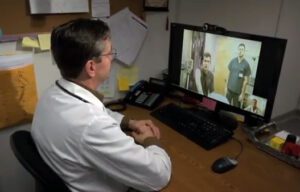 Last week, I participated in a Broadband Access Roundtable Discussion for Vermont’s healthcare providers co-hosted by the USDA – Rural Development and the Vermont Telecommunication Authority (VTA). The half-day event was attended by almost two dozen healthcare experts, federal and state officials, and various IT experts. The goals were to share USDA-RD funding opportunities for telemedicine, exchange best practices, and identify challenges in the utilization of broadband to advance rural healthcare initiatives and, most importantly, to begin to identify the highest priorities for broadband policy going forward as it relates to healthcare.
Last week, I participated in a Broadband Access Roundtable Discussion for Vermont’s healthcare providers co-hosted by the USDA – Rural Development and the Vermont Telecommunication Authority (VTA). The half-day event was attended by almost two dozen healthcare experts, federal and state officials, and various IT experts. The goals were to share USDA-RD funding opportunities for telemedicine, exchange best practices, and identify challenges in the utilization of broadband to advance rural healthcare initiatives and, most importantly, to begin to identify the highest priorities for broadband policy going forward as it relates to healthcare.
I was inspired by the technology innovation stories from Vermont’s healthcare leaders — like those from Michael Wehner, the manager of Fletcher Allen Health Care’s Telemedicine Department — that showcased how broadband and digital tools are bringing more affordable and better healthcare to rural Vermonters. It seems like nearly every medical department at Fletcher Allen is increasingly using digital tools to extend specialty health care services to rural areas.
He explained that the Telemedicine Program provides regional access to high-quality specialty medical consultation, emergency care, and distance education for healthcare providers, students, employees and patients. This is important, because the further away a resident is from an urban area, the increased likelihood that they will not be near a specialist who can effectively treat them.
According to the telemedicine video on the Fletcher Allen website, advanced emergency care used to be delayed by up to 6 hours to patients in the most rural areas of the region. Now, through this program, distance, transportation and physical condition no longer have to be barriers to getting the best medicine. Imagine specialist consultations with local health centers and with regional hospital emergency rooms, using either real-time videoconferencing and or sending diagnostic information via the Internet. For non-emergency consults, primary care physicians can send photos, x-rays, etc. to the specialist (such as a dermatologist) to review and provide feedback. This “Store and Forward” method speeds service delivery and eliminates the need to schedule the patient, the specialist, and the primary care doctor to be available for a joint appointment.
Telemedicine is most commonly and successfully used for mental health services. “A great example is real-time videoconferencing for child psychiatric consultations, which enable the family and child to be in the familiar surroundings of their primary care physicians, rather than having to travel to a distant specialist’s office,” said Wehner.
Even more fundamental and widespread than the videoconferencing techniques and programs described by Fletcher Allen Healthcare is another important aspect to telemedicine: enablement of the electronic health record. This article from the U.S. Department of Health & Human Services explains how the capture and safe dissemination of patient data improves rural healthcare, by quickly arming physicians with the knowledge they need to make diagnoses.
“All of these telemedicine advances rely on having enough Internet bandwidth to send the medical data” said Wehner.
Now that universal broadband in Vermont is much closer to being achieved, we can expect to see increased use of telemedicine to treat patients in rural areas. Those assembled last week at the Broadband Access Round Table discussed several challenges and needs. Most direct care providers identified a common challenge to have enough funding to keep up with technology: hardware, software and increasing needs for bandwidth. There was also general agreement about the value of using Internet communications tools to share information about staff training opportunities and using Internet videoconferencing to save on travel for training.
According to Caro Thompson from the Vermont Telecommunications Authority, “The USDA-RD and the VTA will be assembling notes taken at the event and will make them available to those unable to attend. Looking ahead, we’re also planning an Education Roundtable Discussion scheduled as part of the Vita-Learn Fest in early November.”
